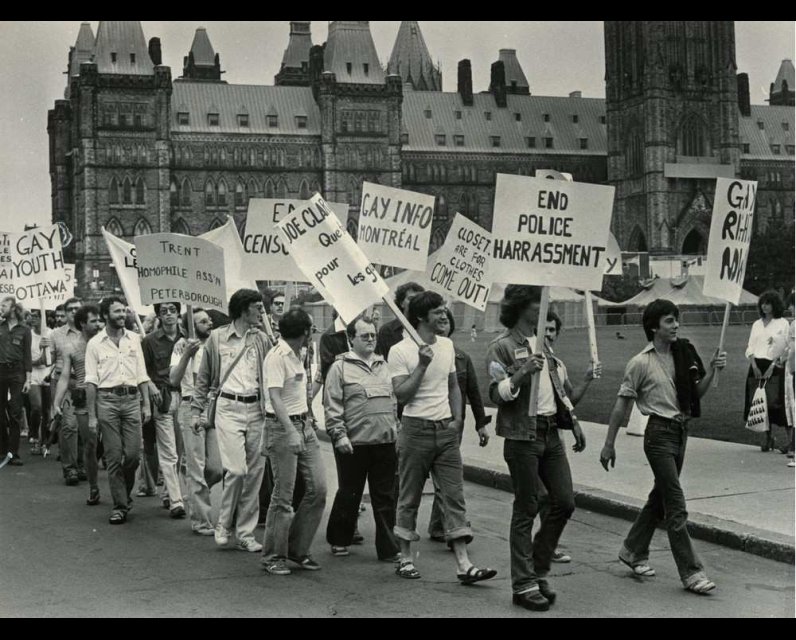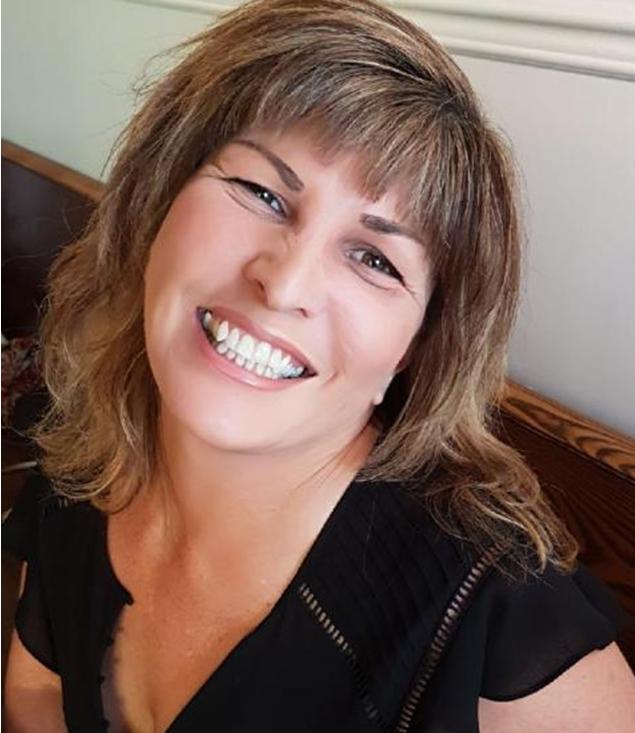Unpublished Opinions
Ottawa Police Services and Capital Pride: Look Back, Before We Repeat A History Not Worth Repeating

A gay rights march held on Parliament Hill in 1979: Photo credit: Postmedia
While there is no summer heat, the conflict between Ottawa Police Services (OPS) and Capital Pride is making up for it. Recently, Capital Pride requested that OPS officers who intend on participating and marching in the Ottawa Pride parade leave their uniforms at home. Not going over well with OPS, nor the Ottawa Police Association, the backlash and one-up-isms are verging on ignorant and petty. Now the focus appears to be on winning and punishing, rather than making the Pride parade what it should be: a celebration of individual rights and sexual choice and our respect and acceptance.
Councillor Allan Hubley suggested cutting off support and funding to Pride, which is a step in the wrong direction and should have never been verbalized: 'old boys club' backward, unconscionable and on its face, discrimination. In fact, it's nothing more than high-handed, negative punishment: if you don't yield, we'll take rightful and facilitating support away from you. Then, Chief Bordeleau tweeted out that he will be marching in uniform in spite of Capital Pride's request. Becoming a mean and contentious contest, where will the chest-beating end?
Truthfully, I don't support Capital Pride's request that officers not wear their uniforms in the parade (self-disclosure: I strive to be inclusive, pro-personal accountability and support ethical policing for the benefit of society). Bottom line, the upcoming Capital Pride parade is a public event and held in a public space and to impose conditions that dictate who can support and attend based on their appearance, profession or associations, privatizes it and borders on its own flavour of discrimination. Worse, it also stands to reduce a progressive movement that at one time was subject to real oppression by police to a farce based on imaginary threats that ignores the progress.
This is not about 'fear' and feeling 'safe' and putting those who feel that way at ease; this has become an agenda, going beyond the argument for inclusiveness and embedding itself in a societal and political position to exercise control. Is there discrimination in policing towards the gay community and racial minorities? Of course, ask any gay or coloured cop, but this is exists in every profession. Is it more egregious because it is the police? Absolutely, but no more than any other first responder profession or any other that delivers service that impacts well-being and justice.
Supporting unreasonable fears to not participate or to exclude others, is not acceptable; it's not society's job to create permissiveness and co-dependence, nor manage individual discomforts and perspectives in the absence of imminent violence or systemic (meaning, a group and its members that embody, feel and act in a particular way) discrimination. Aversion, avoidance and forced changed at the accommodation of others will not advance anything, but exercising tolerance, fairness and accepting the onus to cope and negotiate has at least a fighting chance.
The fact of the matter is, police are authoritarian figures in our communities and whether they show up at a Pride parade in uniform or not, does nothing to change that - and it won't change the purported bias of some police officers and won't improve the relationship between police and the LGBTQ+ community. While the ugly mark of ignorance has not disappeared, it has diminished over time but no without a lot of work. Look at where we were, and look at where we are now.
Sure, you can paint everyone with the same brush but isn't that what Pride fought against for all of these years? The most vocal, and those with opposition to police attending in uniform, appear to have little recollection of the long journey of the gay community to what is now the LBGTQ+ community. Also, it seems little known that when cops show up in uniform at Pride parades, they are sending a message of support for LGBTQ+ and it is serves as a reminder that wearing that uniform in a gay pride parade was a hard-fought right for police within their own ranks.
It's true. Not long ago in 1996, the NYPD was under scrutiny for discriminating against LGBTQ+ people within its own the ranks of the police. NYPD was successfully sued in federal court, and police officers were permitted to participate in the Pride March - while in uniform. They fought to march in uniform. The president of GOAL, the group representing NYPD officers, Brian E. Downey was quoted as saying: "Our cops put a tremendous amount of courage putting themselves on the chopping block, they should be celebrated for it, and not excluded; this is something that we’ve marched for and this is something that we’ve sued for”.
This doesn't mean the police and gay community have had a smooth relationship; Toronto and New York are often cited as two examples of that historically tumultuous relationship. Almost 50 years ago, the Stonewall riots in Greenwich culminated in conflict that was boiling for some time and in many cities, gay men and women were commonly targeted by police as sex workers and deviants and were not accepted in society, except by a minority. Police raided gay bars routinely and gay men and women were violently detained in an effort to eliminate this 'scourge' from our societies. Pride parades were few and dangerous and by and large homosexually was viewed by the public as immoral and linked to pedophilia. The concept or consideration of gay rights, respect or compassion did not exist.
In Toronto in 1981, nearly 300 men were arrested in police raids at four bathhouses, and charged with either owning and operating or being found in a "common bawdy house". This marked as one of the largest raids in Canadian history and also one of extreme violence by police toward gay men - in fact, the bathhouse was destroyed by sledgehammer-wielding police. This wasn't the only raid and but this one event exemplified an undercurrent that raged for decades before this. From here, societal change slowly entrenched itself and human rights began to prevail, in part by the shock expressed by the public.
In Ottawa in the late 1980s, when I was a volunteer with Ottawa's AIDs housing and Pink Triangle Services, I don't recall anyone asking or knowing who or what I was - which was a young, white heterosexual woman with conservative values and professional aspirations in public police and safety. And I don't think it would have mattered; we had a common goal for fairness and equality, without judgement, for people as they were - as people. There were less questions and rules, as more hands made for lighter work. What do I remember during this time? Men in hospice - men brought there to die of AIDs because they were ostracized by their own families. They recounted their journey as gay men and the struggles and stigmas, as they lay dying of a little understood and highly feared disease. Back then, that was how society saw homosexuality; these men died with strangers at their side, without the love and support of their families, because of 'dirtiness' of being gay was often greater than the ties of family blood.
These turning points should not be forgotten. Stonewall was nearly 50 years ago and today, due to the intersection of too many social movement groups with rigid, anti-social agendas, the optic being presented is that the LGBTQ+ community are the ones building a proverbial wall. If this is a matter of making people of colour feel safe, as stated by Capital Pride board chair Tammy Dopson, the validity of this charge doesn't resonate. For me, as a woman in a male-dominated field, if I let my rejection of societal patriarchy manifest as 'fear', I wouldn't have a job to show up to. And if I let it manifest as a demand, I'd be no different than a man who refuses to deal with a woman in a professional setting.
When conflicted with what is right and what is fair, focus on intent. I don't believe for one second that the intent of either side is disingenuous and without compassion, but it's in danger of becoming this. While comparing the pain and experiences of one person to another's is always a poor yardstick, empathizing as best as one can is important for validation of the injustice. Do we need more change on the part of police? Yes, but for those too young to remember, don't forget where we were: 50 years ago, the gay community did experience vicious, systemic and violent oppression by the majority of police, wholly supported by our societies.
While many do not agree with the opinion and decision of Capital Pride, now is not the time to be 'disrupter' or to drive a point home, but a time to focus on compromise and the greater goal of inclusiveness. Show up at Pride and support the LBGTQ+ community, but self-identify as a police officer in another way: replace uniforms with OPS t-shirts, caps or bracelets. Any effort to minimize damage should be held high so that in the coming year a concerted effort to rebuild and improve this important community relationship is possible.
The relationship between police and the gay community has already travelled a long and painful road; doing anything other than easing that distance can only be viewed as self-serving and counter-productive.



Comments
Be the first to comment